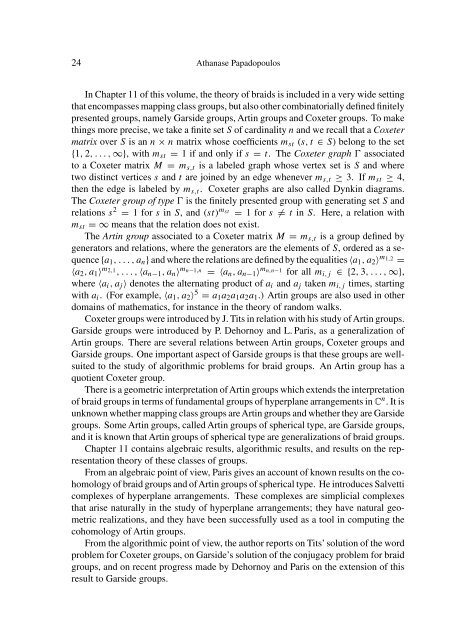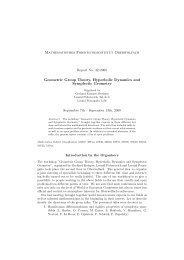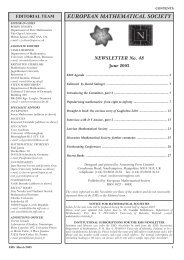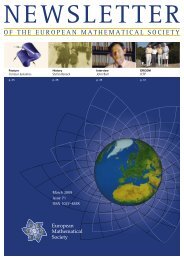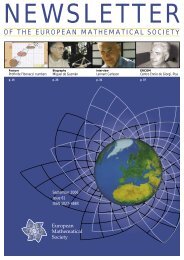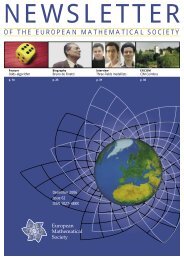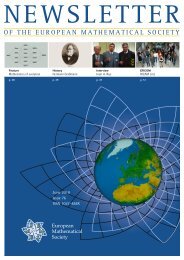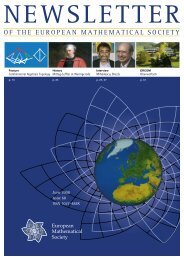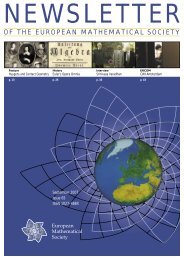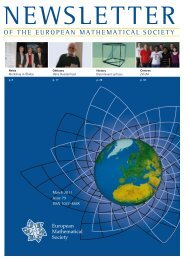Introduction to Teichmüller theory, old and new, II
Introduction to Teichmüller theory, old and new, II
Introduction to Teichmüller theory, old and new, II
Create successful ePaper yourself
Turn your PDF publications into a flip-book with our unique Google optimized e-Paper software.
24 Athanase Papadopoulos<br />
In Chapter 11 of this volume, the <strong>theory</strong> of braids is included in a very wide setting<br />
that encompasses mapping class groups, but also other combina<strong>to</strong>rially defined finitely<br />
presented groups, namely Garside groups, Artin groups <strong>and</strong> Coxeter groups. To make<br />
things more precise, we take a finite set S of cardinality n <strong>and</strong> we recall that a Coxeter<br />
matrix over S is an n × n matrix whose coefficients mst (s, t ∈ S) belong <strong>to</strong> the set<br />
{1, 2,...,∞}, with mst = 1 if <strong>and</strong> only if s = t. The Coxeter graph Ɣ associated<br />
<strong>to</strong> a Coxeter matrix M = ms,t is a labeled graph whose vertex set is S <strong>and</strong> where<br />
two distinct vertices s <strong>and</strong> t are joined by an edge whenever ms,t ≥ 3. If mst ≥ 4,<br />
then the edge is labeled by ms,t. Coxeter graphs are also called Dynkin diagrams.<br />
The Coxeter group of type Ɣ is the finitely presented group with generating set S <strong>and</strong><br />
relations s 2 = 1 for s in S, <strong>and</strong> (st) mst = 1 for s = t in S. Here, a relation with<br />
mst =∞means that the relation does not exist.<br />
The Artin group associated <strong>to</strong> a Coxeter matrix M = ms,t is a group defined by<br />
genera<strong>to</strong>rs <strong>and</strong> relations, where the genera<strong>to</strong>rs are the elements of S, ordered as a sequence<br />
{a1,...,an} <strong>and</strong> where the relations are defined by the equalities 〈a1,a2〉 m1,2 =<br />
〈a2,a1〉 m2,1,...,〈an−1,an〉 mn−1,n =〈an,an−1〉 mn,n−1 for all mi,j ∈{2, 3,...,∞},<br />
where 〈ai,aj 〉 denotes the alternating product of ai <strong>and</strong> aj taken mi,j times, starting<br />
with ai. (For example, 〈a1,a2〉 5 = a1a2a1a2a1.) Artin groups are also used in other<br />
domains of mathematics, for instance in the <strong>theory</strong> of r<strong>and</strong>om walks.<br />
Coxeter groups were introduced by J. Tits in relation with his study ofArtin groups.<br />
Garside groups were introduced by P. Dehornoy <strong>and</strong> L. Paris, as a generalization of<br />
Artin groups. There are several relations between Artin groups, Coxeter groups <strong>and</strong><br />
Garside groups. One important aspect of Garside groups is that these groups are wellsuited<br />
<strong>to</strong> the study of algorithmic problems for braid groups. An Artin group has a<br />
quotient Coxeter group.<br />
There is a geometric interpretation of Artin groups which extends the interpretation<br />
of braid groups in terms of fundamental groups of hyperplane arrangements in C n .Itis<br />
unknown whether mapping class groups areArtin groups <strong>and</strong> whether they are Garside<br />
groups. Some Artin groups, called Artin groups of spherical type, are Garside groups,<br />
<strong>and</strong> it is known that Artin groups of spherical type are generalizations of braid groups.<br />
Chapter 11 contains algebraic results, algorithmic results, <strong>and</strong> results on the representation<br />
<strong>theory</strong> of these classes of groups.<br />
From an algebraic point of view, Paris gives an account of known results on the cohomology<br />
of braid groups <strong>and</strong> ofArtin groups of spherical type. He introduces Salvetti<br />
complexes of hyperplane arrangements. These complexes are simplicial complexes<br />
that arise naturally in the study of hyperplane arrangements; they have natural geometric<br />
realizations, <strong>and</strong> they have been successfully used as a <strong>to</strong>ol in computing the<br />
cohomology of Artin groups.<br />
From the algorithmic point of view, the author reports on Tits’ solution of the word<br />
problem for Coxeter groups, on Garside’s solution of the conjugacy problem for braid<br />
groups, <strong>and</strong> on recent progress made by Dehornoy <strong>and</strong> Paris on the extension of this<br />
result <strong>to</strong> Garside groups.


